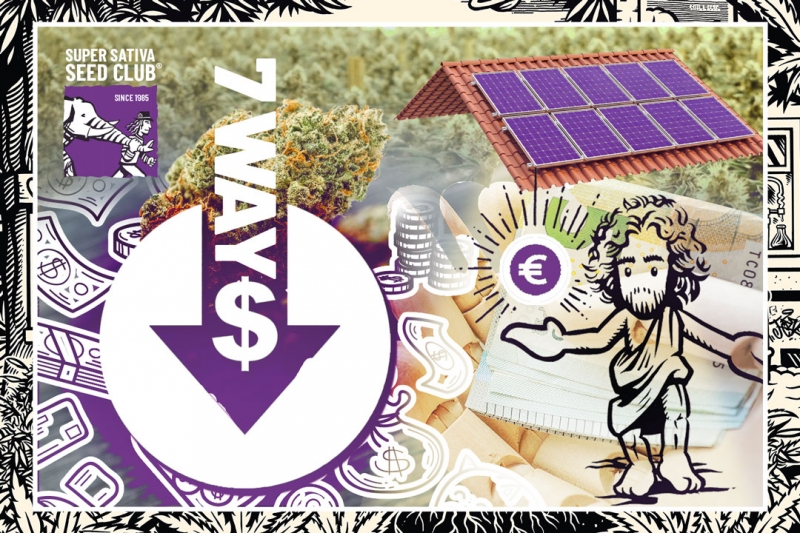
Growing Cannabis indoors can be a time consuming and expensive hobby, and especially in recent times. There is more pressure now than ever before to cut costs, with some growers choosing to reduce the number of grows per year, or simply stop growing. In this article we explain 7 ways to help cut costs, reduce electricity bills and explain our top tip for each, to help lower those hiking electricity bills and give you peace of mind as an indoor grower.
Light Cycles
For the longest time, we have been instructed to vegetate Cannabis plants under an 18/6 light cycle, meaning the plants recieve 6 hours of darkness. Running thousands of watts of high intensity discharge lighting, can not only be very expensive, but also takes 4-6 weeks before plants are ready to be flowered. On the basis that Cannabis plants do not receive more than 12 hours of dark, they will remain in a vegetative state.
The only difference you will notice is that the internodal spacing will be taller the more darkness received. So when comparing a Cannabis plant grown under 20 hours of lights, to one that has been exposed to 14 or 16 hours, there will be a significant difference with internodal spacing, resulting in taller plants prior to flowering.
Our Top Tip: Try setting your times so the plants recieve either 14-16 hours of lighting, before they are flowered. Doing this will allow you to save up to 4 hours per day / up to 28 hours per week and up to 112 hours per month.
Dimmers
In recent years, many lighting manufacturers have chosen to add dimmers to their grow lights, to allow a grower to control the output of power. At the flick of a switch, it is possible to reduce the power by 10-25% increments, so depending on the maturity of the plants, you have some leverage over the output and efficacy of the lights. Dimmers are incredibly effective and will save you large amounts of electricity bills at the end of each month.
Our Top Tip: It is now possible to buy dimmable ballast for HPS and MH lighting, as well as LED. When it comes to how intense the lights your plants receive, it is a good idea to provide 50% power during the vegetative stage, and then to switch to 100% power for flowering once the plants are mature.
Short Flowering Cultivars
If the goal as an indoor grower is to save time and grow as much head stash as possible, in the shortest amount of time, then short flowering strains will work best. Not only do quick flowering plants allow a grower to rotate their flowering rooms faster, they also save on electricity and nutrients. When we describe a short flowering variety, expect a flowering time of 45-56 days.
Our Top Tip: There are many long term benefits to switching to a fast flowering strain, as it allows a grower to potentially shave off 2-3 weeks off each harvests, overall allowing more harvests per year, as well as reducing the chance of plants becoming at risk of pathogens such as Botrytis.
We strongly recommend feminized Kosher Haze and feminized Lava Freeze, Sweet Bourbon Auto Kush, or regular sexed Creamy Kees.
Sea of Green Rotation
For those who are not familiar with the term Sea of Green or SOG, then it simply refers to a method of growing a high volume of plants close together. The principal is to produce a hedge or sea of buds that expands the length of a room or grow space. To give an example, if you had a 1.5 meter tent, then you would plant 25 (5x5 rows) plants in pots no bigger than 7.5 liter pots. The outcome would reveal that these 25 smaller sized plants grown in close proximity, produce the same amount of dried flower as 6-9 large sized plants that have been vegetated for 6-10 weeks.
Our Top Tip: Not every strain is suited for SOG, so we recommend doing some research and learn which strains that different seed banks offer. Kush strains and indica dominant will be best for Sea of Green, as they grow with one main central cola with compact side branching, and avoid sativa dominant plants
Hydroponic Systems
For some growers, the electricity bills may not be their priority, and the only thing they care about is production. Harvesting below par yields every 3 months may also seem counterproductive as finances are concerned and how much personal smoke you have left after a few weeks is questionable. Hydroponic systems are a style of growing that uses a soiless medium containing no nutrients. Growing Cannabis with hydroponic systems can significantly increase yields by up to 300%, and require short vegetative times.
Our Top Tip: Before you jump head first into hydroponics, we recommend that you find a system that is best suited for your skill level. The last thing you want is to be overwhelmed and learn the hard way. Entry level systems such as dripper systems are an ideal starting point, with more complex systems such as deep water culture (DWC) and aeroponics for the more experienced.
Use Feminized Seeds
Feminized seeds are already extremely popular amongst indoor growers across the world. However, if you are new to growing Cannabis, then you may not be aware of the differences between regular sex and feminized Cannabis seeds. Regular seeds require sexing and will produce either male or female plants. Feminized seeds on the other hand are genetically programmed to grow only female plants.
Our Top Tip: There are a wide range of benefits associated with female seeds. There is no need to remove potential male plants early in flowering, allowing space to be fully utilized and for no waste of nutrients or growing medium. We strongly recommend working with feminized seeds as a beginner growers, and to use regular seeds in the event of a homemade breeding project.
What About Solar Panels?
Solar Panels may sound like an expensive investment but are well worth it in the long run, especially in such uncertain economic times. Not everyone can afford to have a set of panels installed, and in most cases you will most likely need to be the property owner.
Our Top Tip: The way which solar panels work is based on brightness and not necessary direct sunlight. Your home stores the solar energy, either as an emergency back up, or if you are fully sustainable, a permanent source of heat and electricity for your home and indoor garden.
Conclusion
We hope that these 6 points will help you as an indoor grower be more aware about how to save on electricity bills. Whether you are changing to a fast flowering strain, reducing your lighting hours down to 14 or 16, using dimmers, switching to hydroponics or investing in Sea of Green, a simple change in the right area can make a huge difference and keep those curing jars full!
(291) (0)

